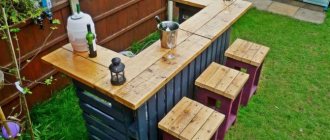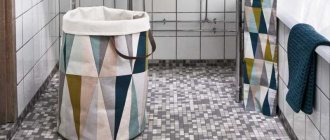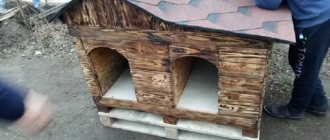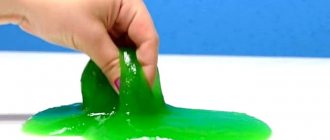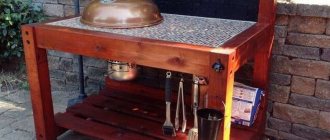Explore Pool Waterproofing
40 step-by-step photo master classes on how you can make the simplest and most inexpensive swimming pools with your own hands at your dacha (dacha plot) or in the courtyard of a private house. Also at the end of the article there are photos of cool frame pools.
The materials from which you can build pools are in this article: from pallets, from metal, from scrap materials, from hay and beer boxes.
As you can see in this example, it doesn’t really matter what the pool frame is made of, the main thing is to use a good and strong film. And in this case, any bed will turn into a heavenly pond for swimming.
- and here it is from beer boxes
Advantages and disadvantages
The possibility of arranging a reservoir without the involvement of specialists or serious financial investments in a capital hydraulic structure is already a huge plus. If we consider the advantages of a pool made of pallets for a summer house in detail, we get the following picture:
- The time for independent arrangement from scratch is from several hours to 2-3 days (depending on the volume, availability of material, number of workers).
- Minimum financial investment (you can only use used materials).
- A fully decorated structure is a spectacular accent of garden design.
- Implementation of the project at all stages is possible alone.
- If necessary, the structure can be dismantled in a few hours.
It would be hard to call the fragility of the design a minus. With minimal investment, it is impossible to create a pool from improvised materials for a long period of time.
Self-assembly of a pool from pallets
User manual
In order for the structure to last as long as possible, it requires maintenance. This will maintain the strength and maintain the load-bearing capacity of the platform.
Maintenance of the structure consists of:
- Periodically inspect visible parts of the platform for damage.
- If necessary, replace the protective coating or elements.
- Construction of a canopy or roof over the platform, this is especially true for wooden and metal products that are easily susceptible to rotting and corrosion.
- Timely coating of wooden elements with varnish or other protective layer.
Important! At the end of the season, for the winter period, it is better to cover the structure with a protective film to avoid the harmful effects of low temperatures, snow, and winds.
Preliminary preparation
You can prepare the base area of the pool in two ways.
Cover the entire substrate on which the pool will sit with a thick plastic or waterproof sheet.
Create the substrate in the same way as the perimeter using wooden pallets. Place them next to each other and you get a raised, flat surface.
In both cases, the bottom of the pool should be insulated with thick plastic or waterproof tarpaulin. Treat the pallets so that the pool looks aesthetically pleasing.
You can then build a perimeter wall. Position the pallets according to the given shape and connect them using fasteners. You can also use strong ropes or wire. In any case, the pallets must be pressed tightly against each other and also secured to the ground.
You can line the inside perimeter wall with old bath towels. The inside of the pool, carefully waterproofed with tarpaulin, is attached to the edge of the pool, which can then be covered with wooden trim.
Don't forget about the steps. You can make classic steps from pallets.
Frequent problems when creating a base for a frame and ways to solve them
High demands are placed on the base of the pool, especially if the structure is voluminous and the water will exert strong pressure. The bowl will stand securely if the weight is distributed evenly. This is one of the difficulties of creating a podium.
To achieve a perfectly flat surface, use a building level. Using a tool, ensure that the deviation is up to 5 mm per m2. Otherwise, deformation of the pool and destruction of supporting supports are likely.
If you cannot level the soil, you need to compact it. The surface should be free of depressions and hillocks, and the top layer should be cleared of vegetation roots and foreign components. Depending on the type of soil, compaction must be carried out by compacting the soil by creating a cushion of sand and gravel.
In order for the pool to last a long time, you do not need to install it on:
- an unfinished foundation that was being built for other buildings;
- soils prone to landslides and sloughing;
- edge of water sources, slopes;
- in the place of old buildings, where cavities may remain and cause collapse.
To prevent anyone from getting hurt by splinters on the boards, they must be sanded and processed.
How to make a pool from pallets with your own hands
Assembling the bowl from scratch requires a few simple steps. As an example, here are instructions with a photo of a pool made from round pallets:
- Assembling the font with your own hands begins with preparing the site. You need a flat place without stones or large vegetation. It is optimal to remove the grass and add a small layer of sand. If you have unnecessary foam boards, they can be used for the substrate. The prepared area is covered with a tarpaulin, and the sides of the font begin to be formed from pallets.
- As each pallet is installed, they are connected to each other with fasteners. First, the pallets can be sewn together with strips, then reinforced with clamps and mounting angles.
- When the sides of the bowl are assembled, they begin arrangement. The inside of the fence is covered with old blankets, carpets, and felt. The soft substrate at the bottom is arranged in the same way.
- The final cover is film. The waterproofing material is spread evenly over the bowl. Overlaps of about 20 cm are made beyond the sides. The edges of the film are fixed with tape. To prevent the round bowl from being crushed by water pressure, it is tightened from the outside with a cable or mounting belt.
- The outside of the font is covered with clapboard or other facing material. Decorative edging is nailed from edged polished boards along the end of the sides. It can be used instead of benches. The board is treated with protective impregnation and opened with transparent or colored varnish.
- The finished pool is filled with water. The structure is inspected for leaks and the strength of the pallet connections is ensured.
To make it more convenient to use the font, install a ladder with your own hands. You can consider lighting for night swimmers.
In the video you can see a DIY pool made from pallets:
A platform made of thick film or linoleum on the sand
To make such a platform you will need:
They act this way:
- Mark the area for the future substrate. To do this, use a long rope and pegs. If the pool is round, one peg is driven in the middle, and with the second a circle is drawn with a diameter 30–40 cm larger than the diameter of the pool itself. For oval pools, you will need to draw 2 such circles along the edges and connect them with lines. To mark an even circle, drive one peg in the middle of the site, and draw a circle with the second (short) one tied
- They dig up turf (10–15 cm) over the entire area and carefully remove the roots of perennial weeds, stones, branches and other debris.
- Pour a layer of sand (the same 10–15 cm). To compact the sand better, it is watered with a hose with a spray nozzle. The layer of sand under the pool should be at least 15 cm
- Level the sand using a steel profile or a long board, rotating it like a clock hand. This work is best done together. Check the levelness of the site by placing a construction level on the board/profile.
- Reinforced film, linoleum or geotextiles are carefully laid on the sand. You can install a swimming pool.
Sand for a large diameter pool can be leveled using construction beacons or ordinary pegs of the same height.
How to do it yourself step by step?
The construction of an artificial reservoir from wooden pallets consists of several successive stages - selection and preparation of a suitable site, construction of the pool bowl, as well as final finishing.
Preparation of the site at the dacha
For the construction of an artificial reservoir from wooden pallets, it is allowed to use only previously prepared areas , without the slightest irregularities, vegetation and stones.
Preparatory work includes several stages:
Marking the site and leveling it.- Designation of boundaries.
- For a buried structure - digging a pit with an area slightly larger than the area of the bottom of an artificial reservoir.
- Filling the bottom of the pit with sand and gravel and compacting it thoroughly. As an alternative, you can simply cover it with foam boards.
- Covering a carefully leveled area with tarpaulin or roofing felt.
Making a homemade bowl
The bowl of the future pool should be formed in the following sequence:
- Arrange wooden pallets close to each other so that the board panels are directed into the structure.
- At several levels (bottom, top and middle), firmly connect them to each other using clamps, mounting angles or self-tapping screws.
- Strengthen the resulting structure with slings, tightening it around the entire perimeter.
- Cover the bottom and inner sides of the reservoir bowl with felt or soft improvised objects - unnecessary carpets, blankets or mattresses. This is done for insulation purposes.
- In the interior space, spread a waterproof film evenly over the soft layers. It should extend beyond the outer side of the sides by approximately 25 cm. It is advisable to use a film of a pure blue shade, which will ensure the aesthetic appearance of the water in the pool.
- Securely secure the film using mounting tape.
- Fill the pool with water to test the waterproofing.
- Tighten the structure along the outside with mounting straps or cables - the result should be something similar to hoops on wooden barrels. This technique will help prevent damage to the bowl under water pressure conditions.
Attention! Considering the relatively short lifespan of a homemade pool made from wooden pallets, you should not install complex and expensive equipment. Vibrating pumps can damage the film bottom. Therefore, it is better to get by with a simple bottom pump that can not only pump water, but also filter it.
Final decoration
After assembling the pool bowl and testing its hermetic properties, you can begin the final stage of work - aesthetic decoration.
To do this you need to perform the following steps:
Place connecting bars or boards on the upper edges and sides of the artificial reservoir bowl between the pallets, ensuring more reliable fixation of the film.- The entire outer side of the frame, including the edge and side parts, should be trimmed with decorative material - for example, plastic or wooden panels, boards or plywood sheets.
- All wooden elements are impregnated with antifungal and moisture-repellent compounds, and then covered with stain, which plays a decorative and protective role.
- If desired, install stairs, gangways and railings.
- Fill the pool with water and check its tightness again.
What can be put under the frame for different forms of relief?
The condition of the site depends on the materials used in its manufacture. Using a substrate you can compensate for some surface imperfections.
Flat land
What to lay under a beautiful swimming pool?
On a flat area, a regular substrate, which can be bought in a retail chain, is sufficient. It consists of several layers of polyethylene foam, sometimes with an additional reflective layer.
If the surface of the platform is insulated, you can use any film (polyethylene or polypropylene, PVC) to separate the insulation from the material of the bottom of the bowl.
Uneven
If the terrain of the site is uneven, the site will have to be made multi-layered. You will need to lay a sand cushion, which is carefully compacted.
Sometimes, on moving and unstable soils, a podium is made around the bowl. An air gap remains between the ground surface and the supporting structure, allowing contact with an unstable surface to be cut off.
Sometimes ASG is used instead of sand if the soil is too loose. Additional layers of cutoff (geotextile or polyethylene) are laid on top of the sand cushion, a concrete screed is poured, or a piece coating is laid.
Step-by-step photos of pallet pools
- And here we found for you a couple of step-by-step photos with master classes on how to make a wooden frame pool from pallets (or pallets).
From a tractor wheel and from a covering awning
- As you can see, it’s not so difficult to make one from a tractor wheel.
- But from the awning, here you already have to figure out that you can pass the steps through the holes in the awning, which remains only to be pulled and secured above ground level!
What requirements must wood meet?
The quality of the finished pool largely depends on the quality of the pallets that are planned to be used for its construction.
These wooden elements are subject to several strict requirements:
- the raw materials are of the highest or first grade;
- coniferous wood - spruce or pine;
- wood of light shades without signs of technical damage;
- integrity of wooden boards.
Attention! Cracks, chips, and protruding nails are not allowed.
Homemade pool from pallets
Having a swimming pool on your property is probably everyone’s dream. However, not everyone can afford such an expensive pleasure. This is exactly what one enterprising Swede thought and built a pool from ordinary wooden pallets. The best part is that the materials cost was no more than $80.
Swede Torben Jung made his own swimming pool from recycled materials.
Torben Jung dreamed of having his own swimming pool on his property. And since the Swede could not afford his purchase, he decided to make a swimming pond with his own hands. Following instructions found on the Internet, Jurgen built a real functional pool. The guy filmed the entire work process with a camera and posted it on social networks so that anyone could invent something similar for themselves.
1. Wooden pallets
Wooden pallets are the basis of the pool.
Tensioning straps strengthen the structure.
Torben installed 9 wooden pallets in a circle, nailing slats on them. To finally strengthen the structure, he used tie straps.
2. Waterproof material and towels
Towels are laid out for softness.
After this, waterproof material was laid out, on which the Swede additionally threw towels. This is done so that the edges and joints do not put pressure on the backs of those who will be in the pool.
3. Another blue waterproof lining
Waterproof blue material.
To give the pool a traditional look, Torben chose another waterproof liner in a blue hue and secured it around the edges with a tray.
4. Bamboo facade
The outside of the pool is lined with bamboo.
The final touch in the construction of the pool was decorating it with bamboo branches, hiding all the internal materials.
5. Water pump
Water is pumped out using a pump.
By the way, Torben also took care of how easy it is to drain the water from the pool. For this he used a pump. Now, if necessary, the guy can easily change the water.
If this craftsman did not have the funds to buy a pool for his site, then for others the opposite is true: the lack of free space becomes a decisive factor.
We are building our own cinema in the courtyard of the house
How and with what to seal the gap between the bathtub and the wall
Sealing
To ensure that the structure does not allow water to pass through, the surfaces of the pallets should be covered with waterproof material. Most often, ordinary polyvinyl chloride fabric is used for this purpose. However, in direct contact with wood, the PVC film may tear. Therefore, the boards themselves are sanded, getting rid of sharp chips and nicks. And then the internal surfaces are protected with a more durable material.
For additional protection, you can use a tarp or other durable fabric. Felt, old blankets or towels are also added for softness. And only then do they use PVC film, securing it along the edges with tape or waterproof glue.
Materials
According to him, it took the blogger 14 standard pallets to assemble the sides of the pool. Another 8 pallets were used to construct the bottom. The blogger used felt to cover the walls and bottom of the pool. But, according to Caleb, you can simply cover the pallets with old wool blankets.
Egyptian craftsmen managed to “revive” Pharaoh Ramses II after reassembly The winner of “The Bachelor” received a luxurious ring from Timati’s hands We remove dampness with ordinary soap: windows no longer fog up and “cry”
The blogger purchased a special film for covering pallets, intended for arranging reservoirs. This film is made of rubber and can withstand heavy loads. Regular greenhouse polyethylene film, according to the blogger, is not suitable for covering swimming pools due to its low degree of strength.
The only thing that can be used when arranging a pool from pallets instead of such a rubber film is an old, intact, tightly stretched ceiling. In any case, according to Caleb, you can only use solid fabric to cover the pool. It will most likely not be possible to seal the joints reliably.
DIY technology for constructing a pool from pallets
Swimming in the pool on a hot day is the dream of most owners of suburban areas. It would seem that such luxury is the prerogative of large landowners who invest substantial money in the development of the territory. But even on a modest 6-10 acres, realizing the dream of splashing around in the summer is not a difficult matter. In a couple of days, an ordinary summer resident can build a pool from pallets with his own hands, and if necessary, disassemble it or move it to another place. In this article we will look step by step at how to build a pool from pallets in a small country house or in the courtyard of a private house.
Which pallets are best to make a pool from?
To assemble a good pool with your own hands, you need durable and environmentally friendly pallets. The service life of the structure, its reliability, and functionality will depend on their quality. To make a pool, you need to choose pallets with the following characteristics:
- they should not be damaged or broken;
- must be well processed (without knots);
- without serious defects.
Among the advantages of pallets it is worth noting:
- absence of harmful substances during operation;
- good strength characteristics;
- low thermal conductivity;
- relatively light weight;
- ease of processing;
- versatility in use.
It is best to use pallets made of coniferous wood - pine, spruce, larch - to make a homemade pool.
The advantages of pine material include:
- color (from yellowish to reddish);
- light and soft texture;
- original recognizable pattern;
- high degree of thermal insulation.
Spruce pallets are also popular among consumers. They have a white color with a yellowish tint, the same soft texture as pine. But spruce has a lower degree of resistance to the process of decay, it has a lower level of resin.
Unlike spruce and pine, larch has a high degree of strength (25-30% higher), which explains its demand in structures with increased reliability requirements. Larch also wins in terms of the number of knots - it completely lacks them. But during the drying process, this material often cracks.
Among the hardwoods most often used for the production of pallets:
- Birch, which is characterized by financial accessibility and high performance characteristics. In addition, it is able to withstand shock loads and does not create difficulties during processing.
- Oak, which has an increased degree of strength, sufficient hardness, beautiful dark color and pattern. The material perfectly withstands excessive levels of humidity and does not cause difficulties during processing.
Comment! Individual parts for pallets are made from juniper and yew, which are resistant to temperature changes, moisture, and very strong. Pallets are an affordable material that allows you to quickly and permanently build an original pool on your backyard plot
Construction rules and requirements for a pool podium
Before you get to work, you need to think through the design and try to make it as safe as possible for all swimmers in the pond, regardless of their age, height and weight. Building a platform for a swimming pool at your dacha with your own hands will require the fulfillment of at least four basic conditions:
- The podium is assembled and mounted as an independent structure on its own support system, without the use of pool frame elements. Only a flexible connection of the frame systems of the podium and the reservoir is allowed, and only at the lower level;
- The podium frame, horizontal surfaces and steps must be treated with protective materials to prevent swelling and deformation of the structure;
- The materials used to line the paths must be sanded to prevent the appearance of splinters or sharp chips. It is best to build a podium for a country pool from a terrace board; it has excellent decorative and tactile qualities and is highly resistant to moisture;
- For manufacturing, only metal and wooden supports are used, no plastic, brick or concrete.
The main requirement in making a frame pool on a podium in a country house, photo, is that the structure should not create additional loads on the frame of the reservoir itself.
For the deck frame you will need to make your own system of beams and posts, without contact with the elements of the reservoir
If you tie together the steps of the podium and the frame of the pool, the bowl on the side of the steps will slowly deform and sag over time, and the polyvinyl chloride membrane can be stretched and even torn at the points of attachment to the racks.
What materials and tools will be required
To build a pool from pallets, you must first draw up a project that will significantly simplify the calculation of consumables and reduce the time for assembling the structure. In most cases, the structure has a rectangular or square shape. As an option, a pool in the form of a polygon, oval or circle is also quite possible, but this will require more serious fasteners. If you use ordinary ones, the structure will be short-lived and may simply fall apart.
If you are planning a medium-sized pool, then you will need about 10 pallets. To erect the vertical walls of a rectangular structure, 4 pallets are used, and for short sides - 3 pieces. Ultimately, a structure with dimensions of 3.2 × 2.4 m should be produced.
For 4 sides of a rectangular font you need to prepare 14 pallets, for laying out the bottom - 6-8 pieces. You will also need a film, but not a greenhouse film; it is not able to withstand significant loads. The best option is the use of black rubber material intended for the construction of artificial reservoirs and swimming pools. This film has increased strength characteristics, sufficient resistance to direct sunlight, and can withstand heavy loads. Its black color attracts heat from the sun better, and the water in the pool will warm up faster.
Another good option would be to use a blue film that has a polymer coating. But it has one drawback - it is expensive.
Advice! To build a pool from rectangular or any other shaped pallets, you can use used PVC film - a suspended ceiling.
When calculating the film, add 20 cm on each side. You should use only solid material; when gluing several pieces, the tightness is not always one hundred percent.
To make an artificial pond at your dacha from pallets you will need the following materials:
- pallets;
- waterproofing material;
- a piece of tarpaulin/linoleum (for upholstering the inside of the pool);
- bottom substrate;
- used blankets, carpets (for insulating the structure);
- self-tapping screws;
- mounting angles;
- staples;
- tape for attaching the film;
- moisture protective agent for impregnation of pallets;
- hammer;
- saw;
- screwdriver;
- construction tape;
- spirit level for monitoring vertical/horizontal walls;
- scissors.
Drafting
The project is compiled either based on the availability of pallets, or, having enough consumables, on the desired volume of the bowl and the height of the sides. Wooden pallets, the standard dimensions of which are 80x120 cm, are installed vertically (side height 120 cm) or horizontally (side height 80 cm).
Round, oval, rectangular or square - these are all possible shapes for tanks. Elongated ponds allow you to swim, while compact ones allow you to passively enjoy the water and the sun. Having settled on the specific shape and volume of the structure, they make a diagram to calculate the amount of materials required for the work.
How to make a pool from pallets with your own hands
To assemble a pool from pallets with your own hands at the dacha, you need to decide on its location, prepare materials and tools. It is important to follow the algorithm of actions.
Preparing the site and arranging the bottom
First of all, it is necessary to mark and achieve a level surface in the area allocated for the installation of the pool.
The optimal depth for a pit for a pool made of pallets is 60 cm
If an artificial reservoir is planned to be of a ruined type, then it is necessary to dig a pit according to parameters exceeding the dimensions of the bottom of the structure made of pallets. It should be 60 cm deep, where 20-30 cm is the “landing” of the structure, 5-10 cm is the thickness of the “cushion”. The laid sand and gravel must be well compacted. Alternatively, the bottom can be made of sheets of foam plastic, penoplex, placing them close to each other.
After this, it is necessary to lay linoleum, roofing felt, and tarpaulin at the bottom of the pit. And then they begin to assemble the sides of the homemade font.
Wall installation and waterproofing
The sides are made of pallets deployed with board panels inside the structure. They need to be fixed at several levels using self-tapping screws, clamps, tightening them with slings along the perimeter 10-15 cm from the ground surface, in the center and 10-15 cm from the top edge of the wall. After this, you need to cover the bowl with unnecessary blankets and floor covering to ensure comfortable conditions while swimming in the pool. These measures will also prevent accidental damage to the film on the board.
It is best to use black rubber film for ponds or blue material with increased strength for arranging a pool
After laying the film and straightening it in all internal corners, proceed to fixing. It is necessary to ensure that there are no voids, the material lies freely, without tension. Using tape, secure the film to the sides from the outside. You can verify the tightness of the pallet structure by filling it with water.
Pump installation and pool inspection
For servicing a homemade hot tub at the dacha, the simplest version of a bottom pump is quite suitable. There are models that not only pump water, but also help filter it.
Decoration
You can give a pool made of pallets a more presentable look as follows:
- Using boards and bars, join adjacent pallets along the top edge. At this stage, you need to fix the film material on the sides.
- Sheathe the outside of the structure with finishing materials such as plywood, boards, and cover it with stain.
- Install a ladder, stairs, handrails. Then fill the tank with water.
Design Features
There are many constructive solutions for independent arrangement of artificial reservoirs. A tank in a pit or an above-ground bowl made of blocks and concrete are capital structures erected once and for many years. Frame pools are a PVC container with a sheathing, a collapsible version. Such pools of different shapes and sizes are sold ready-made, but if you wish, you can make a small swimming pool on a frame with your own hands.
DIY pool
A pool made of pallets is a home-made economy class frame structure. From used materials available at hand, you can quickly and inexpensively set up a comfortable place to relax. The number of pallets available determines whether it will be a small tank for relaxation or a full-fledged pool in which you can swim.
If desired, a pool assembled with your own hands from pallets can be finished so that it lasts for several years. To do this, the platform under the bottom is prepared separately: leveled, covered with pebbles, sand or lined with foam plastic. The slightly recessed (20-30 cm) structure of the pallets will ensure additional stability of the sides under water pressure throughout the entire service life. All wooden elements of the structure are treated with water-repellent impregnation. If a bathhouse made from pallets, assembled for two to three weeks, is often not decorated in any way, then a pool designed for at least 2-3 seasons fits harmoniously into the landscape design of the site.
Mini-pool made from pallets
Advantages and disadvantages
Among the positive aspects of using pallets for making a pool on a personal plot it is worth noting:
- affordable cost of consumables;
- the ability to assemble the structure with your own hands;
- original performance;
- presentable appearance of the finished font;
- practicality;
- the ability to quickly dismantle and move to another location;
- no difficulties when working with pallets;
- long service life with high-quality processing of the frame.
Despite a whole list of advantages, a homemade pond made from pallets also has its disadvantages:
- hydrophobicity of the material used;
- the need to treat wood with special protective impregnations.
Construction progress
- We build shields. Wooden shields must be knocked down. We cover the structure with planed boards. The thickness of the boards must be at least 30 mm so that they can withstand the weight of water.
- We carry out excavation work. At the chosen location for the future pool, we remove all the debris, remove the top ball of earth with a depth of 2/3 of the height of the future walls, make markings slightly larger than the pool itself and set up the boards in the form of an octagon (the contours of the pool). At the bottom of the structure we lay a drain pipe with an outlet beyond the bowl itself. The area allocated for the pool can be covered with sand or tightly laid out with foam sheets. You can also line the area with tarpaulin.
Swimming pool made of wooden pallets
- We install the walls and carry out waterproofing. We construct a wooden flooring from boards, maintaining an inclination towards the sewer pipe. We place wooden panels in the finished pit. We attach them to the wooden bottom using bars. We carefully work with nails or screws from the outside. For greater reliability, we fasten the structure with clamps. To control the water level and for filling, we make special holes. We lay plastic film on the walls and bottom, observing the presence of 3 communication holes - drain, overflow, inflow. We seal all joints with mounting tape. To keep the bottom of the pool soft, you can cover it with blankets, towels or thick felt, and secure them with a stapler (carefully so as not to damage the bottom).
- We fix the walls. We install spacers between the panels and the walls of the pool. We fill the gaps with crushed stone and compact it well. Then we pour cement here. We connect a waste pipe to the general sewer and supply water.
- We decorate the outer side of the pool with wooden or plastic panels, bamboo, and even better - a terrace board, which is more resistant to humidity. You can build sides on top. We cover all wooden structural elements with an antiseptic, and then with stain, varnish or paint (optional).
Swimming pool made of wooden pallets
- We install a ladder to the finished reservoir.
- To purify the water in the pool we use a mounted skimmer.
- We fill the pool with water and check its tightness. If a pool made of wooden pallets does not leak anywhere, the construction work was carried out competently.
Congratulations, your DIY wooden pallet pool is ready for use! As you can see, nothing complicated. Such a water reservoir will decorate your suburban area and will bring a lot of joy to both you and your guests!
Swimming pool made of wooden pallets
We, an organization of experienced specialists, can help you solve your problem with regard to the construction and design of a swimming pool, plunge pools, custom-made Jacuzzis and ponds. We can bring to life everything that does not contradict the laws of physics. Contact us, we will help.
Photo gallery
In this photo gallery we have collected for you more than 15 photos of various photographs, which illustrate step-by-step with photo instructions the processes of building various inexpensive swimming pools.
To enlarge the photo, just click on it
As you can see in this example, it doesn’t really matter what the pool frame is made of, the main thing is to use a good and strong film. And in this case, any bed will turn into a heavenly pond for swimming.
- and here it is from beer boxes
